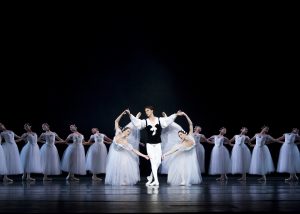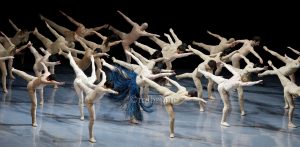The bodies of Fokine, Van Manen and EGPC in the Dutch National Ballet's new programme 'Corps' are vastly different, though they all dance a form of ballet. It is the differences in stakes (decorative or expressive, stylised control or individual surrender, full of symbolism or stripped of it) and the key role for the ensemble that make the programme extremely interesting. Besides the fact that EGPC seems to be on its way to an artistic breakthrough.

At the opening of the new programme 'Corps', Fokine's decorative 'Les Sylphides' can only just charm the audience. Rachel Beaujean studied a new version at HNB in 2004, which is less sentimental and 'fussy' than usual. While the play was revolutionary in 1909 because of its lack of a story, anno 2013 it remains mainly a verhicle for 'clean-dancing'.
'Les Sylphides' is a favourite of ballet practitioners and enthusiasts, but nevertheless limps on two legs: the chorus of dancers -corps de ballet- plays an important role in distributing lines, volumes and rhythms in space. As a fascinating doubler of small gestures, the ensemble actually deserves the lead role. But Fokine apparently felt compelled to combine this relative abstraction with a stripped-down drama for a poet and three muses, a mini-choir that breaks up to dance duets and other spectacles with the poet. Should this capstone have ever worked, present day it feels like a hollow phrase, a decorative dutifulness, especially as dancer Jozef Varga does not seem very inspired. Still, the breathing nothingness wrapped in tulle intrigues. Beaujean's 'naturalness' certainly did the Syphides good.
When a male 'corps de ballet' takes the stage after the usual interval, it becomes clear why, popularity aside, Fokine deserves a place in the programme. In 1985's 'Corps', Van Manen not only reverses roles, but pushes the boundaries of the genre in many ways. The role of a single star dancer is absent. It is much more about dialogues between dancers and much less about aesthetic display in front of an audience.

In 'Corps', no graceful and supposedly uninhibited tripping across the diagonal. The men address the audience boldly and demonstratively. Frontal too are the relationships in the duets with the three dancers, real confrontations that depict an exchange of physical and emotional forces. Ingeniously, Van Manen remodels classical constructions, like an Escher of neo-classical dance. Instead of a waltz by Chopin, we now hear Alban Berg's expressionist violin concerto, beautifully played by Liza Ferschtman. The interweaving and opening up of classical lines and perspectives is given accents by everyday gestures and symbolic gestures. The expression of the dancers is extremely stylised, through-composed. Yet the once innovative value of dancers stepping around and stomping remains palpable. Duetting becomes duelling. The ladies certainly do not let the men chew the fat. The ensemble has a mutual dynamic that, however stylised or clichéd, still impresses. The revival of 'Corps' momentarily quiets my Van-Manen fatigue. This is the modern ballet with which he once conquered the Netherlands and the rest of the world.
After this historical retrospective, it is time for a contemporary work. The Greco-Scholten duo, formerly referred to as EGPC, have been running the choreographic arts centre ICK in Amsterdam for several years. Ballet has been from the first work 'Bianco' in 1996 has been a frame of reference and a recurring source to draw from. In 2011 at Les Ballets de Monte-Carlo, EGPC created a performance with dozens of ballet dancers, 'Le corps du ballet', which has now been rewritten on the body of the Dutch National Ballet.
Although 'the body of the national ballet' begins with a solo, it is fundamentally a group piece. The dancer dances not only for the audience but also for his colleagues. The stage becomes an arena where the dancers come together. As a group, they are not only impressive but also unsettling. The kind of control Fokine and Van Manen call for is shattered in this piece. Instead of stylised bodies in more or less telling poses and interactions, Greco and Scholten send the 30-plus dancers across the stage with structure, material and commitment. The resulting form depends on what the individuals all make of it.
This suddenly results in a very vulnerable 'corps de ballet'. It cannot hide behind front men or prima ballerinas, in whose shadow it is naturally very different to live on stage. For some time, they shield their faces with light masks. Thus EGPC hints at the anomalous dancer who normally populates the ensemble, but also makes the spectator aware of what remains of a body if it is not allowed to put on its own head. Not that the ensemble must now find its way by touch, but I imagine it must also mean something to the dancers to be so locked in their own bubble, toothpaste-smile or flattened face for a moment aside.
Almost hesitantly, the dancers seem to surrender to Greco's energy slurping phrases. And again the visual doubler works. Less organised, more like a texture emerging out of nowhere between bodies, ever-changing weaves of repeated but individually deployed arms and legs, postures and gestures, movements and phrases emerge. Breathtaking clouds of patterned fabric are left on stage by the dancers, mirrored in Joost Rekveld's subtle projections. Anyone with the ballet repertoire and EGPC's oeuvre in their back pocket will recognise the quotes. 'the body of national ballet' is a double reworking of repertoire. The daily fare of many a ballet dancer is infused by Greco with a new energy, personal intentions, a different handling and its own commitment.

Compared to earlier group work by Emio Geco and Pieter Scholten, 'the body of the national ballet' has a much lighter, less dramatic and intrusive feel. The real vulnerability of company dancers having to leave their straitjacket, and also perhaps the fledgling cooperation between ICK and HNB are apparently an advantage. It is almost a pity that symbolic theatrical devices still pop up here and there. The existentialist tree, the blue light of inner sinking that incites rebellion - these are hallmarks of EGPC, as is the soundtrack full of symbolic sound, such as heartbeats, doors slamming into the lock, thunderous applause and demonstration cheers. Delightful are the explosive beats, great is also Henk Danner's lighting, which can't hurt after so much traditional ballet violence, but all in all it also raises a question.
Are the obvious underscores of existential drama, European degeneration and desire for resistance actually necessary? The barrenness of the group, the vulnerability of individual dancers who can no longer assume a fixed form, isn't that existential enough? Recent work by choreographers such as De Keersmaeker and Charmatz has shown that lyrical groups can do very well not only without fixed leading men or women, but also without dramatic lighting and symbolic props. Hidden in the gossamer structures of choreography is a richness that, fleshed out further, could perhaps produce a rebellion all its own. Either way, 'the body of the national ballet' remains a wonderful conclusion to an intriguing triptych with the ballet ensemble, the corps du ballet, as the common thread.
'Corps' can be seen at the Musical theatre, Amsterdam.


